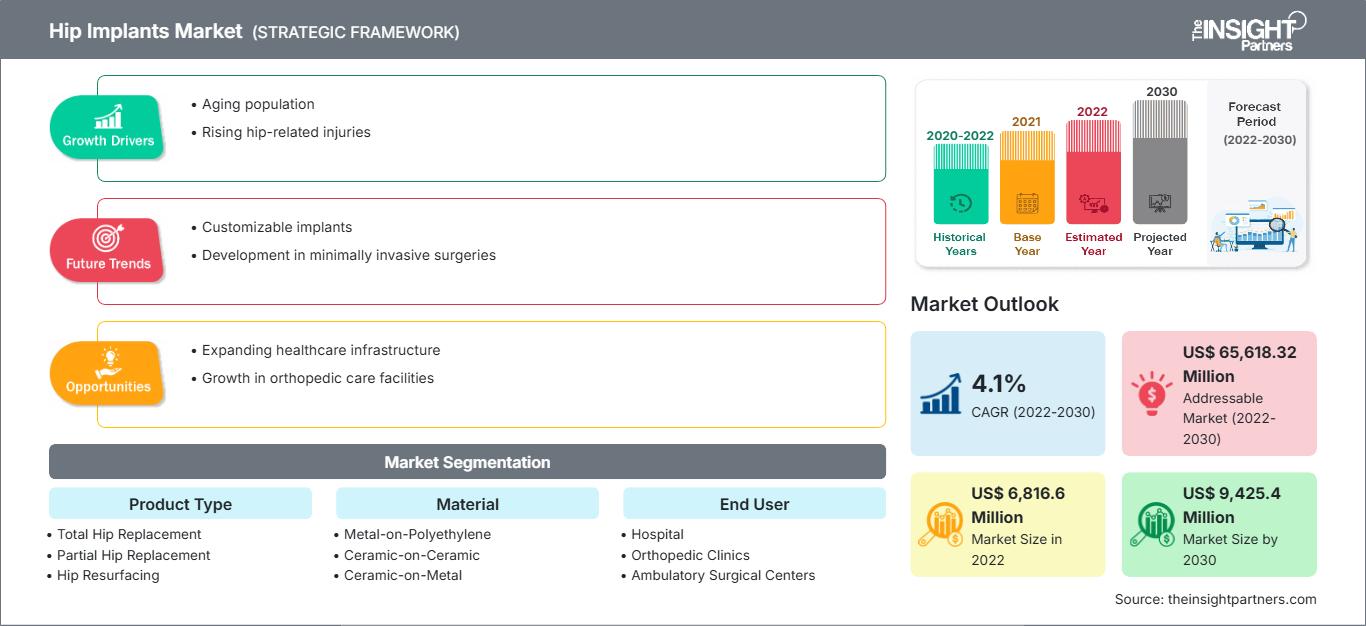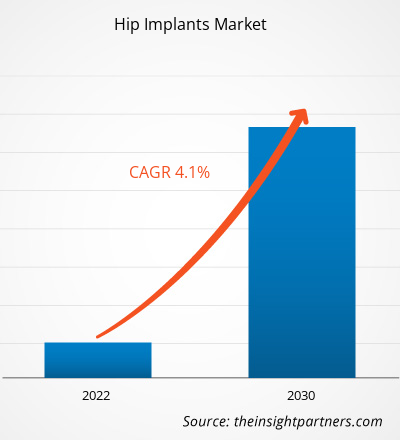[Rapport de recherche] Le marché des implants de hanche devrait passer de 6 816,6 millions de dollars américains en 2022 à 9 425,4 millions de dollars américains d'ici 2030 ; il devrait enregistrer un TCAC de 4,1 % entre 2022 et 2030.
Analyses du marché et point de vue des analystes :
Le marché des implants de hanche connaît une croissance rapide en raison de l'augmentation des chirurgies de la hanche, des blessures à la hanche, de l'arthrose et de la polyarthrite rhumatoïde. De plus, les initiatives stratégiques des entreprises pour rester compétitives alimentent la croissance du marché. Par exemple, Smith & Nephew a lancé le système de double mobilité OR3O en Inde en août 2023 pour l'arthroplastie primaire et de révision de la hanche. OR3O comprend la surface d'appui avancée de Smith & Nephew, OXINIUM DH, grâce à son revêtement et à l'OXINIUM exclusif sur XLPE. Cela élimine à la fois la chemise modulaire en CoCr et/ou la tête sphérique en CoCr de la construction, réduisant ainsi les risques d'usure et de corrosion associés à l'alliage. Ainsi, une augmentation significative des technologies révolutionnaires pour répondre aux besoins des clients est susceptible d'apporter de nouvelles tendances dans les prévisions du marché des implants de hanche.
Moteurs de croissance et défis :
Selon l'Osteoarthritis Action Alliance, l'arthrose est l'une des formes d'arthrite les plus courantes aux États-Unis, touchant près de 32,5 millions de personnes, dont 43 % de la population avait plus de 65 ans en 2020. Selon les Centers for Disease Control and Prevention, environ 23 % de la population américaine souffrait d'arthrite en 2020. Selon Arthritis Research Canada, on estime que plus de 6 millions de Canadiens souffrent d'arthrose, et ce chiffre devrait atteindre 10,5 millions d'ici 2040. L'arthrose peut entraîner des blessures et des fractures de la hanche, car la densité osseuse des patients arthritiques est plus faible que celle des personnes non arthritiques.
L'Organisation mondiale de la santé (OMS) a estimé que la population âgée de plus de 60 ans était d'un milliard. en 2019, et devrait atteindre 1,4 milliard d'ici 2030 et 2,1 milliards d'ici 2050. La part de la population gériatrique devrait passer d'environ 15 % à environ 24 % au cours de cette période. Selon un autre rapport d'Eurostat, l'Europe affichait le pourcentage le plus élevé au monde (20,8 %) de personnes âgées de plus de 60 ans en 2021. De plus, d'ici 2050, dans toutes les régions, à l'exception de l'Afrique, plus de 25 % de la population aura dépassé les 60 ans. Ainsi, l'augmentation de la population gériatrique a accru la prévalence de diverses pathologies orthopédiques, telles que les blessures à la hanche, l'arthrose et les luxations de la hanche dues à des chutes et autres incidents malheureux, ce qui a entraîné une croissance du marché des implants de hanche.
Vous bénéficierez d’une personnalisation sur n’importe quel rapport - gratuitement - y compris des parties de ce rapport, ou une analyse au niveau du pays, un pack de données Excel, ainsi que de profiter d’offres exceptionnelles et de réductions pour les start-ups et les universités
Marché des implants de hanche: Perspectives stratégiques

-
Obtenez les principales tendances clés du marché de ce rapport.Cet échantillon GRATUIT comprendra une analyse de données, allant des tendances du marché aux estimations et prévisions.
Segmentation et portée du rapport :
Le marché des implants de hanche est divisé en fonction du type de produit, du matériau, de l'utilisateur final et de la géographie. Par type de produit, le marché est segmenté en prothèses de hanche de remplacement total, prothèses de hanche de remplacement partiel, resurfaçage de la hanche et prothèses de hanche de révision. Par matériau, le marché est segmenté en métal sur polyéthylène, céramique sur céramique, céramique sur métal, céramique sur polyéthylène, et autres. Par utilisateur final, le marché est segmenté en hôpitaux, cliniques orthopédiques, centres de chirurgie ambulatoire, et autres. Sur la base de la géographie, le marché est divisé en Amérique du Nord (États-Unis, Canada et Mexique), Europe (Royaume-Uni, Allemagne, France, Italie, Espagne, Russie et reste de l'Europe), Asie-Pacifique (Chine, Japon, Inde, Corée du Sud, Australie et reste de l'Asie-Pacifique), Moyen-Orient et Afrique (Émirats arabes unis, Arabie saoudite, Afrique du Sud et reste du Moyen-Orient et de l'Afrique), et Afrique du Sud et Amérique centrale (Brésil, Argentine et reste de l'Amérique du Sud et centrale).
Analyse segmentaire :
L'analyse du marché des implants de hanche, par type de produit, est segmentée en reconstruction fémorale, reconstruction acétabulaire, resurfaçage de la hanche, implants de hanche de révision, technologies de roulement et de métal poreux et implants de remplacement total. En 2022, le segment des implants de remplacement total détenait la plus grande part de marché des implants de hanche et devrait enregistrer le TCAC le plus élevé entre 2022 et 2030.
Par matériau, le marché est segmenté en métal sur polyéthylène, céramique sur céramique, céramique sur métal et céramique sur polyéthylène. En 2022, le segment métal-plastique détenait la plus grande part de marché des implants de hanche et devrait enregistrer le TCAC le plus élevé entre 2022 et 2030. La croissance du segment est tirée par des avantages tels que la précision des résultats, la durabilité et la rentabilité. De plus, d'autres avantages, tels que la réduction des complications, les avancées technologiques et la réduction des particules d'usure, alimentent la demande d'implants de hanche métal-plastique.
Par utilisateur final, le marché est segmenté en hôpitaux, cliniques orthopédiques, centres de chirurgie ambulatoire, etc. En 2022, le segment hospitalier détenait la plus grande part de marché des implants de hanche et devrait enregistrer le TCAC le plus élevé entre 2022 et 2030. Le nombre croissant d'interventions chirurgicales pour implants de hanche en milieu hospitalier stimule la croissance de ce segment à l'échelle mondiale. De plus, le personnel hospitalier est bien formé et conscient des complications pouvant survenir pendant ou après l'intervention. Il est formé pour gérer les urgences et prodiguer des soins équilibrés aux patients. Les procédures de remboursement des interventions chirurgicales sont également facilement accessibles et peuvent être gérées par la direction de l'hôpital. De plus, le nombre croissant d'hôpitaux dans le monde devrait maintenir la domination du segment et tirer parti de la croissance du marché des implants de hanche au cours de la période de prévision.
Analyse régionale :
Géographiquement, le rapport sur le marché des implants de hanche est divisé en Amérique du Nord, Europe, Asie-Pacifique, Moyen-Orient et Afrique, et Amérique du Sud et centrale. L'Amérique du Nord est le principal contributeur à la croissance du marché mondial des implants de hanche. L'Asie-Pacifique devrait afficher le TCAC le plus élevé dans les prévisions du marché des implants de hanche de 2022 à 2030. L'incidence croissante des implants de hanche, les lancements de produits et les blessures sportives à la hanche sont les principaux moteurs de la croissance du marché aux États-Unis. Selon l'article « Hip Fracture Care and National Systems », Selon une étude publiée par Wolters Kluwer Health, Inc., environ 250 000 à 300 000 personnes sont hospitalisées chaque année aux États-Unis pour une fracture de la hanche. On estime également qu'environ 500 000 personnes seront prises en charge par des professionnels de santé pour une fracture de la hanche d'ici 2040. Selon l'Académie américaine des chirurgiens orthopédiques, les personnes âgées de 65 ans et plus sont sujettes aux fractures de la hanche dues à des chutes dans le cadre familial ou communautaire aux États-Unis. Selon l'article « Hip Overview » publié dans la National Library Medicine, les patients dépensent environ 40 000 dollars américains la première année suivant une fracture de la hanche, et le coût total des soins pour les fractures de la hanche aux États-Unis s'élève à près de 17 milliards de dollars américains par an. Ainsi, la prévalence croissante des fractures et des blessures de la hanche aux États-Unis, ainsi que l'augmentation des dépenses consacrées à leur traitement, constituent la tendance actuelle du marché des implants de hanche aux États-Unis.
Aperçu régional du marché des implants de hanche
Les tendances régionales et les facteurs influençant le marché des implants de hanche tout au long de la période de prévision ont été détaillés par les analystes de The Insight Partners. Cette section aborde également les segments et la géographie du marché des implants de hanche en Amérique du Nord, en Europe, en Asie-Pacifique, au Moyen-Orient et en Afrique, ainsi qu'en Amérique du Sud et en Amérique centrale.
Portée du rapport sur le marché des implants de hanche
| Attribut de rapport | Détails |
|---|---|
| Taille du marché en 2022 | US$ 6,816.6 Million |
| Taille du marché par 2030 | US$ 9,425.4 Million |
| TCAC mondial (2022 - 2030) | 4.1% |
| Données historiques | 2020-2022 |
| Période de prévision | 2022-2030 |
| Segments couverts |
By Type de produit
|
| Régions et pays couverts |
Amérique du Nord
|
| Leaders du marché et profils d'entreprises clés |
|
Densité des acteurs du marché des implants de hanche : comprendre son impact sur la dynamique commerciale
Le marché des implants de hanche connaît une croissance rapide, portée par une demande croissante des utilisateurs finaux, due à des facteurs tels que l'évolution des préférences des consommateurs, les avancées technologiques et une meilleure connaissance des avantages du produit. Face à cette demande croissante, les entreprises élargissent leur offre, innovent pour répondre aux besoins des consommateurs et capitalisent sur les nouvelles tendances, ce qui alimente la croissance du marché.

- Obtenez le Marché des implants de hanche Aperçu des principaux acteurs clés
- Analyse historique (2 ans), année de base, prévision (7 ans) avec TCAC
- Analyse PEST et SWOT
- Taille du marché Valeur / Volume - Mondial, Régional, Pays
- Industrie et paysage concurrentiel
- Ensemble de données Excel
Rapports récents
Rapports connexes
Témoignages
Raison d'acheter
- Prise de décision éclairée
- Compréhension de la dynamique du marché
- Analyse concurrentielle
- Connaissances clients
- Prévisions de marché
- Atténuation des risques
- Planification stratégique
- Justification des investissements
- Identification des marchés émergents
- Amélioration des stratégies marketing
- Amélioration de l'efficacité opérationnelle
- Alignement sur les tendances réglementaires






















 Obtenez un échantillon gratuit pour - Marché des implants de hanche
Obtenez un échantillon gratuit pour - Marché des implants de hanche